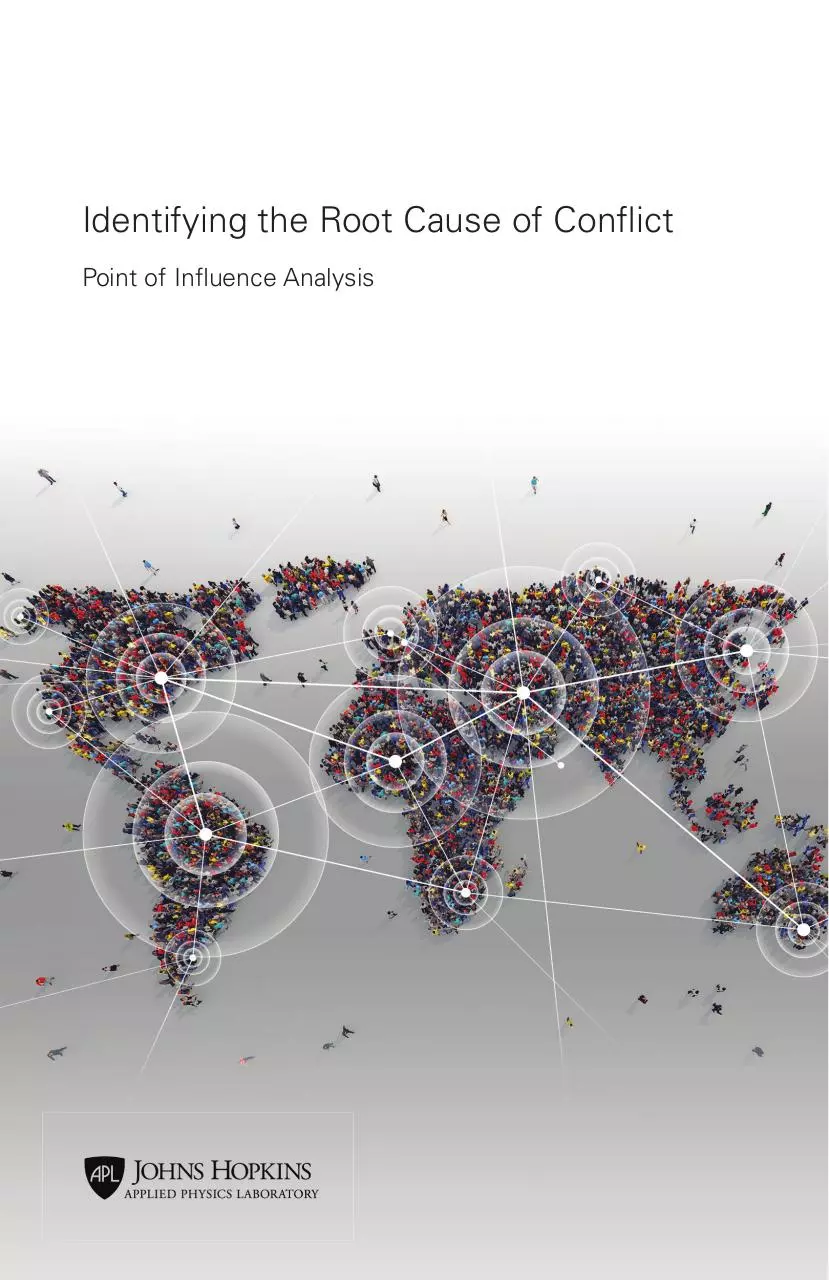PIA Bifold (1) (PDF)
File information
Title: 17-01660_Phillips_Bifold_Bold.indd
This PDF 1.3 document has been generated by Adobe InDesign CC 2017 (Macintosh) / Adobe PDF Library 15.0, and has been sent on pdf-archive.com on 20/06/2017 at 16:16, from IP address 198.7.x.x.
The current document download page has been viewed 277 times.
File size: 3.29 MB (4 pages).
Privacy: public file




File preview
Point of Influence Analysis
Point of Influence Analysis (PIA) is a scalable, cross-discipline, multistep,
systems-based analytic process that enables analysts to identify the RCC
and isolate ways to impact the human environment in alignment with
strategic guidance. PIA may be descriptive (a value-neutral assessment
where the analyst avoids any perspective associated with adversarial and
friendly roles) or prescriptive (a perspective-based assessment assigning
friendly and adversarial roles).
The four PIA steps are
1
2
3
4
Research
Conflict
Assessment
Point of Influence
Identification
Integration
into Planning
PIA implementation can be scaled to the operational environment,
enabling assessment from the local level to the national or regional
level, and can be used to inform tactical, operational, and strategic engagement strategies.
Addressing the RCC
The United States has a vested interest in peace. The rise in foreign
fighters, Western terrorist incidents, radicalization in and threats to the
homeland, and modern violent conflict requires a population-centric
mission focus that includes consideration of the RCC. Using tools such
as PIA to address the RCC increases the United States’ potential to
reach a strategically desirable end state, resolve violent conflict, and
protect its homeland and interests overseas.
Identifying the Root Cause of Conflict
Point of Influence Analysis
Doctrine offers many models that help the planner design courses of
action that are aligned with strategic objectives. These models do not,
however, provide a cross-disciplinary theory–based analytical structure
to evaluate the human environment and to identify the root cause(s) of
conflict (RCC). To address this analytic gap, the United States Army John F.
Kennedy Special Warfare Center and School and the Johns Hopkins
University Applied Physics Laboratory partnered on a research effort to
identify the key components of the human environment to facilitate
RCC analysis.
Political
climate
Human
Dynamics
Grievances
Drivers and
mitigators
History of
conflict
Religiosity
Resiliencies
The Human Environment
is a series of intersecting systems
and their complex, dynamic,
multidirectional, overlapping,
and mutually influential
relationships.
Activation
factors
Social
structure
Human
Factors
Conflict
Connectors and
dividers
Demographics
Cultural
factors
Identities
Groups
Wealth and power
distribution
Human
Geography
The Human Environment
For analysts to gain an understanding of the human environment, their
research must reveal the elements of the environment—conflict, human
dynamics, human factors, and human geography—as well as their
associated key factors.
These key factors are based in multiple disciplines, including sociology,
psychology, political science, anthropology, criminology, and economics.
It is via careful exploration of the human environment through the
lenses of these disciplines that we define the human environment as
a complex adaptive system with a dynamic nature as well as (often
nonlinear) relationships and links, patterns, and interconnectedness
between its parts.
PoI
PoI
Activation
factors
PoI
Friendly
element action
PoI
PoI
Adversarial
element action
Root cause
of conflict
Condition(s) or perception(s) that prime the
environment for conflict
and generate the
activation factors
Activation
factors
PoI
PoI
Activation
factors
PoI
PoI: Point of influence
PoI
PoI
Friendly
element action
PoI
Adversarial
element response
Today’s Need for an RCC Analytic Tool
Today’s joint, interagency, intergovernmental, and multinational environment
necessitates that a RCC analytic tool do the following:
Provide a common language
• Meet requirements across
organizations
• Make sense of chaotic,
contradictory, and ambiguous
conflict environments
• Nest within existing planning
tools
•
• Incorporate a systems approach
that integrates analysis of all
relevant aspects of the human
environment and their complex
relationships
• Support the integration of other
analytic methodologies
• Include a theory of change that
enables the design of metrics
Download PIA Bifold (1)
PIA_Bifold_ (1).pdf (PDF, 3.29 MB)
Download PDF
Share this file on social networks
Link to this page
Permanent link
Use the permanent link to the download page to share your document on Facebook, Twitter, LinkedIn, or directly with a contact by e-Mail, Messenger, Whatsapp, Line..
Short link
Use the short link to share your document on Twitter or by text message (SMS)
HTML Code
Copy the following HTML code to share your document on a Website or Blog
QR Code to this page

This file has been shared publicly by a user of PDF Archive.
Document ID: 0000615184.